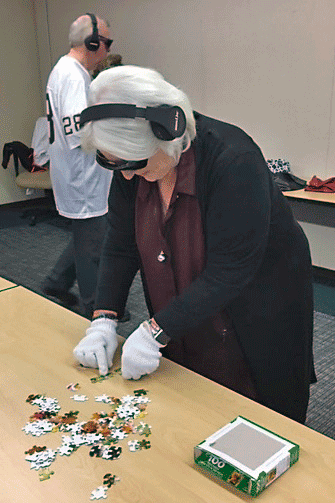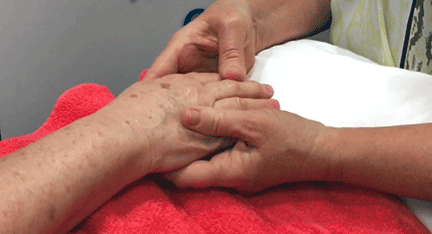Kathy Dreyer, Ph.D., AGE-u-cate® Training Institute
 Federal and state initiatives aimed at culture change and person-centered dementia care are calling upon providers to equip care partners with practical tools. Those tools must generate knowledge in providing person-centered care that creates positive outcomes for people living with dementia and their family, staff and the community. That knowledge must include understanding a person’s preferences and needs, as well as what works best for interacting with and caring for a person living with dementia.
Federal and state initiatives aimed at culture change and person-centered dementia care are calling upon providers to equip care partners with practical tools. Those tools must generate knowledge in providing person-centered care that creates positive outcomes for people living with dementia and their family, staff and the community. That knowledge must include understanding a person’s preferences and needs, as well as what works best for interacting with and caring for a person living with dementia.
At the core of person-centered dementia care is relationships. In the long-term care setting, nurturing a relationship between care partners involves many factors. Empathy can play a critical part of establishing a meaningful care partner relationship and has long been identified as a desired quality in health care professionals, linking it to improved resident and care provider satisfaction scores.
Empathy is defined as “the capacity to be affected by and share the emotional state of another, assess the reasons for the other’s state, and identify with the other, adopting his or her perspective.”1 Simply put, “empathy is being able to put yourself in someone else’s shoes for a while so you can imagine what it is they are going through.”2
There are two distinct types of empathy. Affective empathy refers to feelings that arise in response to another person’s emotion or experience. Cognitive empathy refers to the ability to recognize and understand another’s emotions and reactions to their experiences.3
To support care partners in developing and using empathy, learning models in the long-term care setting must emphasize the need to connect learning on an individual level. Two models that embrace the need for helping learners connect information both cognitively and emotionally, are Kolb’s experiential learning model4 and the confluent education model5.
Experiential learning has been defined as “learning in which the learner is directly in touch with the realities being studied” in a way that bridges the gap between cognitive and affective learning.5,6 Kolb’s process represents a cycle where the learner experiences, reflects, thinks, and acts. Concrete experiences lead to observations and reflections about the experience. These reflections are then absorbed and processed into concepts which lead to motivated action.
Confluent education is described as four domains:
- Readiness– Willingness and preparation for learning: in the long-term care setting, learners should be given time to attend training without sacrificing care.
- Cognitive/Mind– Information and intellectual process: learners should be engaged at their level of learning in a way that is meaningful and appropriate.
- Affective/Feelings– Emotional reaction during and after the learning activity: learners should be given permission to react emotionally at work, and feel they are in a safe space to express their emotions and process their reactions.
- Responsibility/Application– Harnessing the relevance of what is learning and making a connection to everyday life or work: learners should be able to relate what they are learning to how it fits in their work environment, where it applies, and how it will suit them and their care recipients.
 Empathy can help professionals connect more fully with people they are caring for, creating pathways for relationship-building, more person-centered care, and understanding the person’s needs and preferences. It also supports and validates the need for care partners to act on individual’s needs and preferences. The ability to deeply connect and relate to the person in a more meaningful way empowers care professionals to provide the best, most appropriate person-centered dementia care possible. When people are engaged intellectually, emotionally, socially, soulfully, and/or physically, the journey of true person-centered care can begin.
Empathy can help professionals connect more fully with people they are caring for, creating pathways for relationship-building, more person-centered care, and understanding the person’s needs and preferences. It also supports and validates the need for care partners to act on individual’s needs and preferences. The ability to deeply connect and relate to the person in a more meaningful way empowers care professionals to provide the best, most appropriate person-centered dementia care possible. When people are engaged intellectually, emotionally, socially, soulfully, and/or physically, the journey of true person-centered care can begin.
The team at Pioneer Network has seen the value of experiential learning at sessions held over the years at our annual conference. These have included opportunities provided by the team from Age-u-cate® for the attendees of the 2018 and 2019 Pioneering a New Culture of Aging Conference to engage in experiential learning through the Dementia Live® Experience and Compassionate Touch®. And stay tuned for more opportunities in 2020!
References:
1 Waal, F. (2009) The Age of Empathy. Three Rivers Press. New York, NY.
2 How to be an Empathetic Caregiver. American Senior Communities. Retrieved from https://www.asccare.com/how-to-be-an-empathetic-caregiver/
3 What is empathy? Greater Good: Science of a Meaningful Life. Retrieved from
http://greatergood.berkeley.edu/topic/empathy/definition
4 Francke, A. and Erkens T. (1994) Confluent education: an integrative method for nursing (continuing) education. Journal of Advanced Nursing 19, 354-361.
5 Stover, C. (2010) Use of a Confluent Education Strategy to Develop Empathy in Nursing Students. Journal of Nursing Education (49)12, 719-720. DOI: 10.3928/01484834-20101117-04.
6 Kolb, D. (2015) Experiential Learning: Experience as the Source of Learning and Development. Pearson Education, Inc. Upper Saddle River, NJ.


